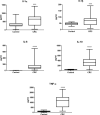May the Nitrosative and Carbonyl Stress Promote Inflammation in Patients with Colorectal Cancer?
- PMID: 35979507
- PMCID: PMC9377401
- DOI: 10.2147/JIR.S374387
May the Nitrosative and Carbonyl Stress Promote Inflammation in Patients with Colorectal Cancer?
Abstract
Purpose: Overproduction of reactive nitrogen species (RNS) causes the nitrosative stress, which plays a vital role in the development of metabolic, inflammatory, and cancerous diseases. However, the role of nitrosative and carbonyl stress in the biology of colorectal cancer (CRC) is still not well understood. Therefore, this study evaluated nitrosative stress, protein and DNA oxidation/glycoxidation, and pro- and anti-inflammatory cytokines in CRC patients compared with healthy controls.
Patients and methods: Fifty-five CRC patients (21 women, 34 men) and 55 healthy controls matched for sex and age were included in the experiment. Nitrosative stress parameters (nitric oxide (NO), peroxynitrite, S-nitrosothiols, and nitrotyrosine), protein oxidation (total thiols) and glycoxidation products (kynurenine N-formylkynurenine, dityrosine, Amadori products, and amyloid), and DNA damage markers (8-hydroxydeoxyguanosine (8-OHdG)), as well as levels of pro- and anti-inflammatory cytokines, were measured in serum or plasma samples.
Results: The levels of NO, peroxynitrite, S-nitrosothiols, nitrotyrosine, total thiols, kynurenine, N-formylkynurenine, dityrosine, Amadori product, amyloid, and 8-OHdG, as well as IL1α, IL1β, IL6, IL10, and TNF-α, were significantly higher in CRC patients than in controls. Oxidation and glycoxidation products were positively correlated with pro-inflammatory (IL1α, IL1β, IL6, TNFα) and anti-inflammatory cytokines (IL10), indicating that redox damages may promote inflammation in CRC patients. Many redox biomarkers differentiate patients with CRC from healthy individuals with high sensitivity and specificity.
Conclusion: Correlations of chosen oxidative products with pro-inflammatory (IL1α, IL1β, IL6, TNFα) and anti-inflammatory cytokines (IL10) suggest that redox damages may promote inflammation in CRC patients. Thus, our research is the first point for further clinical trials focusing on the evaluation of the diagnostic utility of nitrosative stress biomarkers in a larger group of CRC patients.
Keywords: colorectal cancer; cytokines; inflammation; nitrosative stress.
© 2022 Dorf et al.
Conflict of interest statement
The authors declare that they have no competing interests.
Figures






Similar articles
-
Could circulating biomarkers of nitrosative stress and protein glycoxidation be useful in patients with gastric cancer?Front Oncol. 2023 Jul 12;13:1213802. doi: 10.3389/fonc.2023.1213802. eCollection 2023. Front Oncol. 2023. PMID: 37503318 Free PMC article.
-
Significance of nitrosative stress and glycoxidation products in the diagnosis of COVID-19.Sci Rep. 2024 Apr 22;14(1):9198. doi: 10.1038/s41598-024-59876-w. Sci Rep. 2024. PMID: 38649417 Free PMC article.
-
Association of Tumour Microenvironment with Protein Glycooxidation, DNA Damage, and Nitrosative Stress in Colorectal Cancer.Cancer Manag Res. 2021 Aug 12;13:6329-6348. doi: 10.2147/CMAR.S314940. eCollection 2021. Cancer Manag Res. 2021. PMID: 34408493 Free PMC article.
-
The complex interplay of iron metabolism, reactive oxygen species, and reactive nitrogen species: insights into the potential of various iron therapies to induce oxidative and nitrosative stress.Free Radic Biol Med. 2013 Dec;65:1174-1194. doi: 10.1016/j.freeradbiomed.2013.09.001. Epub 2013 Sep 12. Free Radic Biol Med. 2013. PMID: 24036104 Review.
-
Therapeutic targets of oxidative/nitrosative stress and neuroinflammation in ischemic stroke: Applications for natural product efficacy with omics and systemic biology.Pharmacol Res. 2020 Aug;158:104877. doi: 10.1016/j.phrs.2020.104877. Epub 2020 May 12. Pharmacol Res. 2020. PMID: 32407958 Review.
Cited by
-
Uncovering the Effects and Molecular Mechanisms of Shaoyao Decoction Against Colorectal Cancer Using Network Pharmacology Analysis Coupled With Experimental Validation and Gut Microbiota Analysis.Cancer Med. 2025 Mar;14(6):e70813. doi: 10.1002/cam4.70813. Cancer Med. 2025. PMID: 40119640 Free PMC article.
-
Proinflammatory Microenvironment in Adenocarcinoma Tissue of Colorectal Carcinoma.Int J Mol Sci. 2024 Sep 19;25(18):10062. doi: 10.3390/ijms251810062. Int J Mol Sci. 2024. PMID: 39337548 Free PMC article.
-
Could circulating biomarkers of nitrosative stress and protein glycoxidation be useful in patients with gastric cancer?Front Oncol. 2023 Jul 12;13:1213802. doi: 10.3389/fonc.2023.1213802. eCollection 2023. Front Oncol. 2023. PMID: 37503318 Free PMC article.
-
Fashionable, but What is Their Real Clinical Usefulness? NLR, LMR, and PLR as a Promising Indicator in Colorectal Cancer Prognosis: A Systematic Review.J Inflamm Res. 2023 Jan 7;16:69-81. doi: 10.2147/JIR.S391932. eCollection 2023. J Inflamm Res. 2023. PMID: 36643953 Free PMC article. Review.
-
TTLL12 has a potential oncogenic activity, suppression of ligation of nitrotyrosine to the C-terminus of detyrosinated α-tubulin, that can be overcome by molecules identified by screening a compound library.PLoS One. 2024 Feb 23;19(2):e0296960. doi: 10.1371/journal.pone.0296960. eCollection 2024. PLoS One. 2024. PMID: 38394155 Free PMC article.
References
-
- Ferlay J, Ervik M, Lam F, et al. Global cancer observatory: cancer tomorrow. Lyon, France: International Agency for Research on Cancer; 2020. Available from: https://gco.iarc.fr/tomorrow/en. Accessed November 23, 2021.
LinkOut - more resources
Full Text Sources

